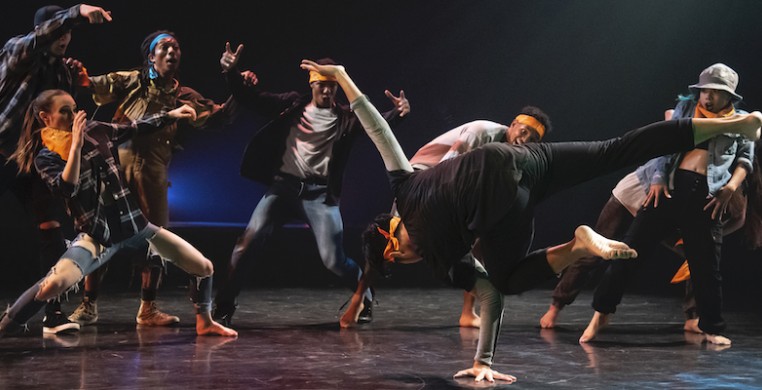Right away it was clear that this is not your average Pinocchio.
Lights softly faded in at the beginning of Chicago Dance Crash’s “Lil Pine Nut: The Learning Curve of Pinocchio” to reveal a stage empty except for dancer Monternez Rezell, as Geppetto, in the corner, spinning a record on a small DJ stand. Ditching Geppetto’s puppet shop for a hip hop and breakdance studio, Chicago Dance Crash smoothly established their modern take on the classic story that would later lead to inventive partnering, footwork to The Beach Boys and never-ending spectacle.
Running through August 30 at the Ruth Page Center for the Arts, “Lil Pine Nut” uses Chicago Dance Crash’s hybrid of contemporary dance, hip-hop, breakdance and acrobatics to embody themes of independence, self-responsibility and responsibility for others.
The show pulls inspiration from Carlo Collodi’s 1883 novel "The Adventures of Pinocchio", but with the exception of the Talking Cricket’s role as satirical narrator and coach to Pinocchio (or Lil Pine Nut, played by Elijah Motley), much of the storyline for this production remains recognizable to anyone familiar with Disney’s "Pinocchio". An innocent puppet-come-to-life is tricked or pressured into much of the misfortune that befalls him. But while the storyline may have seemed rather literal, the way the story was told was not. Chicago Dance Crash’s athletic yet theatrical dancing expanded upon the notion of movement as a communicator to creatively illustrate scenes that people of all ages and all dance experience levels could engage in, understand and enjoy.
This accessibility of the production is what makes “Lil Pine Nut” so captivating. With very little dialogue, each scene relies on the inventive use of ensemble dancing and the colorful characters embodied by the Dance Crash company to move the story forward.
It was refreshing to see a work of dance theater where the focus was as much on athleticism as it was the story, in a way that mirrored the structure of a ballet but showcased contemporary and hip-hop dance.
Using elements of puppetry and puppet-esque partnering, Chicago Dance Crash fittingly illustrated what it means to give in to vices that have strings attached, and to allow others to control or puppeteer us into making decisions that maybe we wouldn’t normally make. This control was first depicted through duets and trios where Lil Pine Nut and other puppets were pulled through performative dances via bands that attached their wrists and ankles to that of the puppeteers. Stunning stunts ensued where bands became tangled and untangled as one puppet was pushed into a front flip, then a spin, then a side flip followed by a slide back along the floor to once again untangle the bands.
This obvious puppeteering became more nuanced as Lil Pine Nut matured. Bands were replaced with human contact, as Jo Fox (the primary antagonist and con artist of the tale, depicted by Porscha Spells) directly pushed, pulled, rolled and spun Pinocchio into following her schemes.
The most meaningful movement happens inside the whale, where Lil Pine Nut breaks free of his physical and metaphorical bonds to instead support to his father, resulting in a series of mystifying lifts--including one where Geppetto rests vertically, his shoulder in the crook of Lil Pine Nut’s, feet suspended into the air.
Through “Lil Pine Nut,” Chicago Dance Crash proved that spectacle can hold deep meaning and that antiquated stories can be reinvigorated through engaging movement.
Concert dance can often take on a more serious or formal tone, in part due to the significant trend among Chicago choreographers towards creating work that comments on contemporary society and social responsibility. It was refreshing to see Chicago Dance Crash tackle a story about maturity, freedom and self-sacrifice in a way that was both fun and meaningful to experience.
--
"Lil Pine Nut: The Learning Curve of Pinocchio" continues through August 30 at the Ruth Page Center for the Arts, 1016 N. Dearborn St. Tickets are $15-$25, available by clicking the event page below.


